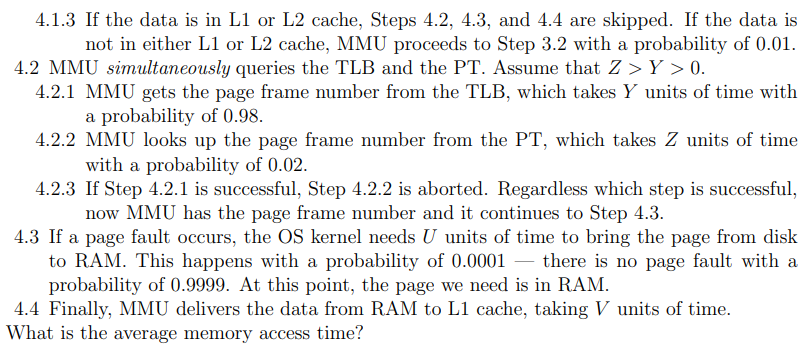The memory system has L1 and L2 cache, the translation lookaside buffer (TLB), and a page table (PT). When the data at an address is needed, the memory management unit (MMU) takes the following steps. 4.1 MMU simultaneously looks up the data in L1 and L2 cache. 4.1.1 If the data is in L1 cache, MMU spends no time for this step. This happens with a probability of 00
The memory system has L1 and L2 cache, the translation lookaside buffer (TLB), and a page table (PT). When the data at an address is needed, the memory management unit (MMU) takes the following steps. 4.1 MMU simultaneously looks up the data in L1 and L2 cache. 4.1.1 If the data is in L1 cache, MMU spends no time for this step. This happens with a probability of 00
Database System Concepts
7th Edition
ISBN:9780078022159
Author:Abraham Silberschatz Professor, Henry F. Korth, S. Sudarshan
Publisher:Abraham Silberschatz Professor, Henry F. Korth, S. Sudarshan
Chapter1: Introduction
Section: Chapter Questions
Problem 1PE
Related questions
Topic Video
Question
Subject:

Transcribed Image Text:The memory system has L1 and L2 cache, the translation lookaside buffer (TLB), and a page
table (PT). When the data at an address is needed, the memory management unit (MMU)
takes the following steps.
4.1 MMU simultaneously looks up the data in L1 and L2 cache.
4.1.1 If the data is in L1 cache, MMU spends no time for this step. This happens with a
probability of 0.9.
4.1.2 The data is in L2 cache. This takes X units of time and happens with a probability
of 0.09.

Transcribed Image Text:4.1.3 If the data is in L1 or L2 cache, Steps 4.2, 4.3, and 4.4 are skipped. If the data is
not in either L1 or L2 cache, MMU proceeds to Step 3.2 with a probability of 0.01.
4.2 MMU simultaneously queries the TLB and the PT. Assume that Z> Y > 0.
4.2.1 MMU gets the page frame number from the TLB, which takes Y units of time with
a probability of 0.98.
4.2.2 MMU looks up the page frame number from the PT, which takes Z units of time
with a probability of 0.02.
4.2.3 If Step 4.2.1 is successful, Step 4.2.2 is aborted. Regardless which step is successful,
now MMU has the page frame number and it continues to Step 4.3.
4.3 If a page fault occurs, the OS kernel needs U units of time to bring the page from disk
to RAM. This happens with a probability of 0.0001 - there is no page fault with a
probability of 0.9999. At this point, the page we need is in RAM.
4.4 Finally, MMU delivers the data from RAM to L1 cache, taking V units of time.
What is the average memory access time?
Expert Solution
This question has been solved!
Explore an expertly crafted, step-by-step solution for a thorough understanding of key concepts.
This is a popular solution!
Trending now
This is a popular solution!
Step by step
Solved in 3 steps

Knowledge Booster
Learn more about
Need a deep-dive on the concept behind this application? Look no further. Learn more about this topic, computer-science and related others by exploring similar questions and additional content below.Recommended textbooks for you

Database System Concepts
Computer Science
ISBN:
9780078022159
Author:
Abraham Silberschatz Professor, Henry F. Korth, S. Sudarshan
Publisher:
McGraw-Hill Education

Starting Out with Python (4th Edition)
Computer Science
ISBN:
9780134444321
Author:
Tony Gaddis
Publisher:
PEARSON

Digital Fundamentals (11th Edition)
Computer Science
ISBN:
9780132737968
Author:
Thomas L. Floyd
Publisher:
PEARSON

Database System Concepts
Computer Science
ISBN:
9780078022159
Author:
Abraham Silberschatz Professor, Henry F. Korth, S. Sudarshan
Publisher:
McGraw-Hill Education

Starting Out with Python (4th Edition)
Computer Science
ISBN:
9780134444321
Author:
Tony Gaddis
Publisher:
PEARSON

Digital Fundamentals (11th Edition)
Computer Science
ISBN:
9780132737968
Author:
Thomas L. Floyd
Publisher:
PEARSON

C How to Program (8th Edition)
Computer Science
ISBN:
9780133976892
Author:
Paul J. Deitel, Harvey Deitel
Publisher:
PEARSON

Database Systems: Design, Implementation, & Manag…
Computer Science
ISBN:
9781337627900
Author:
Carlos Coronel, Steven Morris
Publisher:
Cengage Learning

Programmable Logic Controllers
Computer Science
ISBN:
9780073373843
Author:
Frank D. Petruzella
Publisher:
McGraw-Hill Education